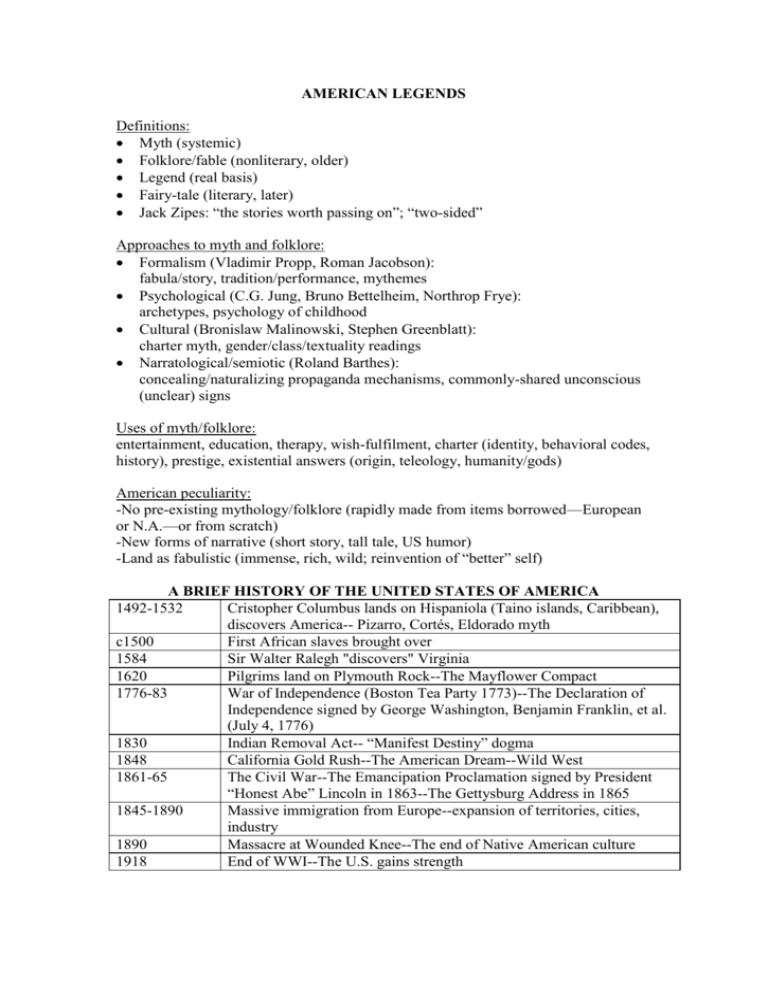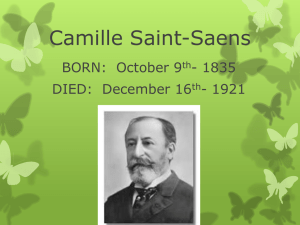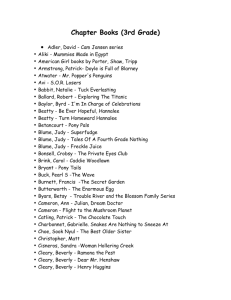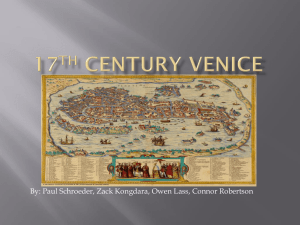Class Outlines
advertisement

AMERICAN LEGENDS Definitions: Myth (systemic) Folklore/fable (nonliterary, older) Legend (real basis) Fairy-tale (literary, later) Jack Zipes: “the stories worth passing on”; “two-sided” Approaches to myth and folklore: Formalism (Vladimir Propp, Roman Jacobson): fabula/story, tradition/performance, mythemes Psychological (C.G. Jung, Bruno Bettelheim, Northrop Frye): archetypes, psychology of childhood Cultural (Bronislaw Malinowski, Stephen Greenblatt): charter myth, gender/class/textuality readings Narratological/semiotic (Roland Barthes): concealing/naturalizing propaganda mechanisms, commonly-shared unconscious (unclear) signs Uses of myth/folklore: entertainment, education, therapy, wish-fulfilment, charter (identity, behavioral codes, history), prestige, existential answers (origin, teleology, humanity/gods) American peculiarity: -No pre-existing mythology/folklore (rapidly made from items borrowed—European or N.A.—or from scratch) -New forms of narrative (short story, tall tale, US humor) -Land as fabulistic (immense, rich, wild; reinvention of “better” self) A BRIEF HISTORY OF THE UNITED STATES OF AMERICA 1492-1532 Cristopher Columbus lands on Hispaniola (Taino islands, Caribbean), discovers America-- Pizarro, Cortés, Eldorado myth c1500 First African slaves brought over 1584 Sir Walter Ralegh "discovers" Virginia 1620 Pilgrims land on Plymouth Rock--The Mayflower Compact 1776-83 War of Independence (Boston Tea Party 1773)--The Declaration of Independence signed by George Washington, Benjamin Franklin, et al. (July 4, 1776) 1830 Indian Removal Act-- “Manifest Destiny” dogma 1848 California Gold Rush--The American Dream--Wild West 1861-65 The Civil War--The Emancipation Proclamation signed by President “Honest Abe” Lincoln in 1863--The Gettysburg Address in 1865 1845-1890 Massive immigration from Europe--expansion of territories, cities, industry 1890 Massacre at Wounded Knee--The end of Native American culture 1918 End of WWI--The U.S. gains strength ΝΑΤΙVΕ AMERICAN CULTURE -Origins from Siberia, cir. 11.000 B.C.E. -2,000 yrs. later had reached the tip of S. America -At least 2.000 separate cultures ίn North America alone - -Ν.Α. culture was not seen as worthy of consideration until into the 19th century (H.R. Schoolcraft) -Nature-oriented way of life and religion -Νο notion of land ownership -Orature and oral tradition; the stories have most often been written down by those outside the culture. -Notion of secret sacred stories. -The stories are simple linguistically, but more sophisticated psychologically. History of the Νative American eradication by the whites in North America Ι. SouthEast -1828: Gold discovered ίn Georgia. -5-28-1830: The Indian Removal Act authorized by President Andrew Jackson, based on the dogma of "Manifest Destiny" -1831-38: The forced removal of the five "civilized tribes" to west of the Mississippi: -June-December 1838: Cherokee "Trail of Tears": Cherokee removed to Oklahoma, 1.000 miles west. 1/3 dies of disease, starvation, or the elements. 11. Great Plains -1848-49: Gold discovery ίn California. -1874: Gold rush ίn Black Hills, S.D. -1876: Battle of the Little Big Horn: Custer vs. Sioux (Sitting Bull), Cheyenne and Arapaho. -Spring 1890: Vision of Wovoka (shaman of the Paiutes): Ghost Dance for the return of the Messiah, the ancestors' spirits, the land and the buffalo. -12-29-1890: Massacre at Wounded Knee, S.D. NATIVE AMERICAN CREATION MOTIFS The Emergence (4 stage; kiva) The Earthdiver (Turtle Island) Twins, Sky Woman, Spiderwoman Trickster THE IROQUOIS CREATION 5(6) Nations League, founded by Hiawatha Sky Woman (virgin birth, cosmic body like Tiamat) Cooperation of animal and divine world Twins (natural duality) Christian influence THE HOPI EMERGENCE 4 colors, corn types, world levels, body vibratory centers vegetable growth as evolution Taiowa (Earthmaker)—Sotuknang (Trickster)—Spiderwoman—creation Twins motif THE WINNEBAGO TRICKSTER CYCLE Trickster: Coyote, Rabbit/Hare, Spider, Raven, Jay, Manabohzo, Wakjankaga The sacred profane (scatology) Fluidity, changeability, entertainment Charter, aetiology: no gluttony, low position of women Water as cathartic element THE ODJIBWA CORN HERO Wunzh as pacific hero (VS Geronimo): agrarian VS warrior tribe ethos “Wrestling with the angel” motif (c/c Bible) Shamanism Corn as dying-rising divinity (kachina doll) The importance of the kiva (“sweat lodge”) chamber WOWOKA OF THE PAIUTES Messiah vision Ghost Dance—Massacre at Wounded Knee (Black Elk) Regeneration motif—spirit world, therapy myth THE PURITAN ORIGINS OF AMERICA November 11, 1620: Mayflower lands on Plymouth Rock; the Mayflower Compact European separatism: “Pilgrims”, the “saints”, the “Elect”, the “New Israel”, the “Chosen People” Goodie, Goodman, American Adam New Jerusalem, City on a Hill Puritan work ethic Teleology, typology, predestination, saving grace Thanksgiving (1621) The “Devil’s Territory”; the Salem Witch trials Hellfire & brimstone sermons (Jonathan Edwards, 1700s) William Bradford First governor of Massachusetts Bay (Plymouth) colony Of Plymouth Plantation retrospective “journal” (1630-50) I. The Crossing of the Atlantic: Myth of corrupt, sinful Europe Politico-religious community (VS Elizabethan England); bourgeois tradesmen God as director/ punishes wicked, rewards good Fabulistic/typological, teleological elements (events, vocabulary) II. The New Eden/ Devil’s Territory Native relations: prejudice VS reality VS teleology (corn as manna, Squanto and Samoset as “angels”) First Thanksgiving—ritual, epic on-the-go WHY WAS PURITANISM PREVALENT, IF THEY WERE NOT MAJORITY ON MAYFLOWER OR AMERICA (100 colonists, 50 dead from 1621 plague)? Cotton Mather (grand)son of Increase Mather and John Cotton; last of old-line Puritan celebrities; gifted scholar/historian Magnalia Christi Americana “The Wonders of the Invisible World” -The Salem Witch trials (Feb. 1692-March 1693): Tituba as scapegoat mass hysteria 150 arrested, 19 hung+ 6 tortured to death judgement unofficially questioned (Mather as “revisionist” via textuality) -the trial of Martha Carrier: paranormal events for “facts” accusers were neighbors, wanted her land -Effects: McCarthyism and the “Red Scare” in the 1950s WHY SUCH DEVIL PARANOIA AMONG THE “SAINTS”? TEXTUALIZATION=FABULIZATION Genl. Phil Sheridan, “The only good Indian is a dead Indian.” N.A. extinction by 1890—sense of “American” nation complete Henry Wadsworth Longfellow -One of the 5 Fireside Poets of 19th century -Lyrical themes, myths and legends, -Easy, musical memorable form for mass entertainment -Skillful adoption of intricate European ballad forms -The Song of Hiawatha (1855) metrically after the Finnish Kalevala -Original 16th century Hiawatha an Iroquois 5 nations hero (uniter); HWL’s “Hiawatha” an Odjibwa trickster/god Manabohzo -Initial distaste at Indian subject replaced by immense popularity, many parodies -Hiawatha as: a. trickster (terraformer); aetiology b. liminal hero; charter myth c. Freudian subject (Oedipus complex) -motif of the exchange of “lethal weapon” secrets -the heroic quest (helpers, gifts, the Boon, the return) -Poem ending: surrender to coming Christianity (preacher on canoe) BUT if one cannot erase one’s roots, where does new religion stand? Vachel Lindsay 19th century poetaster, “Prairie Troubadour” (singing performative poems) “The Congo” (1914) “The Ghosts of Buffalos” -theme as guilt -description of NA (“devilish”, animal like) BUT -“sic transit Gloria mundi” and “ubi sunt?” (are whites next?) -contagious energy, joy (sacred profane, ecstasy) -poet as “shaman”? vision reduced to dream specters passing into oblivion, not returning for real (C/c Ghost Dance) no contact with spirit wisdom Other: evil, but haunts in folklorized form CUSTER’S LAST STAND History as text, many interpretations-views -Native account: Custer under perjury—personal hubris to blame -White account: metaphysical elements—fatalism, defeat as foreordained, “haunting” of battleground -Team spirit, team event -Choice of language, allusions to Leonidas’ 300—propaganda U.S. MONSTERS -Df. unknown, uncanny (Freud’s unheimlich), terrifying, portentous -Symbolic monstrosity -American land -Otherness (Natives) -settling hardships -destruction of the family/societal bonds -unholy VS holy monstrosity (savage VS awesome nature—the White Beast) -P.T. Barnum’s Circus freakshow -“Bigfoot”: if not dangerous, why monstrous? female (Nature), mysterious, aberrant size, own species -our own fear of regression (throwback to Primal Mother, ape-like evolutionary state) -furry, fleeting, fearsome, fascinating: the incest taboo (Freud) vagina dentata motif -“The Jersey Devil” -physical VS metaphysical emphasis (Quaker religion from Puritan p.o.v.) -changeling tradition -Julia Kristeva’s “the abject” (Powers of Horror) -function: charter scare against women, children fear of procreativity as birthing inner demons words (pronouncements) as fetishes -The Wendigo/Loup-Garou/Carcajou/Packer -Native origin: the Hopi Ogre -the taboo of cannibalism -metaphor for: greed (rugged VS rampant individualism) harsh north American winter multiculturalism (theme, language): good or monstrous? loose social ties+ harsh survival masculinity run wild -double irony of “he ate all the Democrats” few Democrats democracy not an individualist/ tough enough concept (in the land of “Democracy”!) -“The Skeleton Hand” -European origin of tale: Schütz= “shooter”; German “wulde Jagd” (wild hunt); St. Hubertus and the White Stag/Hart -the meaning of the beast labors -stag as worldwide mythological symbol: natural divinity or fabulistic American nature as unnatural? “La Llorona” -“woman in white” motif (succubus; water-nymph: rusalka, lamia) -physical VS metaphysical emphasis (la familia, religion) -changeling tradition reversed (mother as horror) -Julia Kristeva (Powers of Horror): abject motherhood -function: charter scare of complaining women, cheating men anxieties of the oppressor -water (tears) and white color symbolism: womb-tomb motif woman as water-related (Tethys; Tiamat; Yemanjá; Mermaid; Grendel’s mother) Santa Muerte cult linear vs cyclical time femininity (woman as angel-abject) -the import of rivers as time in folklore symbolism Moby-Dick -“HERMAN MELVILLE CRAZY” reaction to tale, BUT -knowledge and use of the power of exotic folklore -“a whale of a tale” literally Biblical references o The importance of the whale/Leviathan (compare with the Kraken; piety test) o Ahab, Adam (knowledge imperative) o Dotted forehead: Ahasuerus, (mark of) Cain o Miltonic Satan (scar, “vast but hollow” chest, call to vengeance with pointless war against Heaven, hatred of incomprehensible creation—wish to strike through the “mask” of nature at “that inscrutable thing” which “is chiefly what I hate”) o Satanic ritual Call and response pattern “nailing” the gold piece on the mast oath on grog (“Satan’s hoof,” “serpent”) momentary cessation of the elements “subterranean laugh” at Starbuck’s invocation of God’s protection 3-lance oath—harpoon hollow as “chalice” Sea as the savage and marvelous “continent” Moby Dick traits: o “ubiquitous” (mysterious pathways) o ferocious ,wrathful o gigantic o marked, crooked, corkscrewed, humpback o “immortal” o “all evil” of the world (acc. to Ahab) o white, wrinkled forehead Meaning of whiteness o White Dog, Stallion, Bull, Stag, Buffalo, Swan, albino o the (super) natural American land o veil of incomprehensible/Kant’s sublime/Wittgenstein’s “things shown” as more important than “things told” The hunt for white flesh Ahab’s pegleg with deck slot: castrated Oedipal son sea as “Mother Womb/Tomb” (rocking and sinking boat) whale as Abject Feminine (feeds and scares) ending: incest punished—death in amniotic whirlpool, tied to umbilical harpoon-rope STRONGMEN Long hunter (Natty Bumppo in James Fenimore Cooper’s Leatherstocking Tales) Backwoodsman Hunter/trapper Logger Mountain-man pioneers “faith in the portable, portable faith” (Stephen Fender) rugged individualist effects of early frontier life on the individual -the American “noble savage” -American man as half-monstrous, half-beast -(public) tall boast, tall tale/yarn, rip-roarers, slang (later liar’s clubs) -What kind of model of masculinity/femininity do those legends present? The Warrior Woman -Why “scary”, “ugly”, “creature”, “Mad” Ann Hennis? -gender-bending and performativity (Judith Butler); androgyny -family destroyed by frontier life -ambivalent relation to Natives villains, she destroys them gets tomahawk and warrior skills from them (berdash) -the harnessing of threatening female power: marriage, work for US Army Mike Fink (1770 Pittsburg-1822 Yellowstone River) -river system as first commercial/settler route network -keelboats and broadhorn flatboats -“helliferocious” archetype of rampant individualist “Kentucky-style” fighting, machismo and misogyny, racism -Natives presented as cannibals, rapists, cowards, prostitutes, worthless -tortures saintly wife Peg -tugs at squaw as if to split her, hits her -shows more affection for rifle “Betsy” -fights with and murders “son”, dies of guilt -Why is such a figure lionized? “getting the (dirty) job done” Archetypal Freudian Taboo Father/Lacanian “Father of Enjoyment” -what causes his misogynistic behavior? Puritan condemnation of “sin” as feminine” Envy, survival psychology, women as cause of fight (Trojan War) Homosociality -his daughter an “unwomanly” copy of him: pretty, superpowerful and patriotic, but -attacks mama bear -works only for male institution (US army) -why no sons for Fink? Sal and Peg as anima Paul Bunyan -“fakelore” (Richard Dorson) -maybe a Canadian axman, Paul Pierre Bonhomme/Bonjon/Bunyon -Red River Lumber Co. logo -Newspaper stories by cartoonist W.B. Laughead (1906/14) -giant lumberjack at Northern Canadian border (daughter Peg a logger too); pipeline (oil) driller in the South; brother Cal Bunyan a railroad worker Bunyan as synonym for huge might of U.S. industry -Jean Baudrillard’s “the astral and the primitive” -symbol of carefree, unthinking nature despoilment -giant mosquitobees, beasts, rough terrain: fabulistic nature provides excuse for its own despoilment -flood, Big Onion river move, duststorms, Puget Sound hole from uprooted tree, the Mississippi as burst watertank, straightening river, tides of Nova Scotia, Grand Canyon by axe-drag, etc: affects U.S. landscape (C/c terraforming Trickster) -true American: rough, hard-working, a fellow, businessman, innovative, practicallytaught, no culture yet outsmarts Johnny Inkslinger to work for him -homosocial traits: a. Babe/Benny, the Little Blue Ox: force of icy nature, but has feminine traits, more “ladyfriend” than “companion” (saved, a pet, faithful, helpmeet, capricious, gluttonous, mischievous, fat/lazy, not too smart-can be tricked, gets gifts from Paul, called “she” in “Pipeline Days”) b. Paul’s “wife” a peg-leg hag c. Babe’s cow-wife, Betsy, not too popular d. Paul dances the woman’s part with the 7 Axmen GO WEST, YOUNG MAN -Pioneers, homesteaders/settlers, pathfinders, trailblazers -“Ohio Fever” -The Prairies -The Conestoga wagon (“prairie schooner”), axe, rifle -Professional soldiers along with privateers -Jean Baudrillard’s “The cowboy and the skyscraper” as symbolic coordinates of America Davy Crockett -18th century Southern “Colonel”; “King of the Wild Frontier” -Coonskin cap ring-tailed roarer -Archetypal American: rugged backwoodsman popular orator, Congressman for 8 years -Brains AND brawn -Died at the 13-day Siege of the Alamo by Genl. Santa Anna (March 1835) during Texas War of Independence (1835-36) -C/c to : Christopher (Kit) Carson, “Monarch of the Prairie”, Rocky Mt. beaver trapper and Jack-of-all-trades : Daniel Boone, Quaker deerhunter and Indian fighter : Jim Bowie, Southern gentleman “Colonel”, inventor of the Bowie knife, cutthroat, slaver (business with pirate Jean Lafitte, “Lost Bowie mine” a hoax) C/c Sam Colt, inventor of the six-shooter (revolver) Heroic death while gravely ill at the Alamo Why make a scoundrel into a romantic hero? -The importance of the Alamo Closing early settling era U.S.A. fully-formed, not just survivor, but virtuous Heroic past martyrized Johhny Appleseed -Jonathan Chapman, 19th century PennsylvaniaOhio pioneering -Northeast apple industry -Puritan missionary spirit Swedenborgianism (mystical union with God and charity) -Ralph Waldo Emerson’s Transcendentalism -The first hippie? -Sainthood a la Americana VS alternative story -The semiology of planting apple orchards into the Wild: “hieros gamos” MEN OF STEEL/STEALING MEN America as “the astral and the primitive” (Jean Baudrillard, America) The importance of technology Cult of the (youthful) body The Tommyknockers -C/c the Niebelungen, kobold, (Snow White’s 7) dwarves Stephen King novel -Miner (prospector) camps (the Gold Rush) -Perkin Basset as rampant capitalist, haunted by: friend’s debt grudge over prostitute family dissolution (wife + child) -Appeased by return to communal virtues: family, homemaking, civility, frienship -Basset as a liminal hero between life and death (mine metaphor) John Henry -Afro-American lore: Br’er Rabbit/Fox/etc. stories, Aunt Nancy (Ananse), Tar Baby, the blues -black body fetish: Black Adonis, Black Venus as racist rationalization -black pride: “Africa in him” as JH’s strength : ballad as “call-and-response” oral storytelling pattern : Steel (Superman comic, film with Shaquille O’Neal) -Big Bend Tunnel of C&O: steel-driver pride: tough job, built America BEFORE machines black labor obliquely acknowledged (community role) human sacrifice motif (C/c Arta Bridge) humanity (predicts death, sweats, weeps, falls sick, dies) VS heroism (mythical origin, appetite, physique) man vs machine (who wins?) Joe Magarac -fakelore -immigrant ambivalence: jackass and contribution to industry -literal “man of steel” -the “melting pot” assimilation VS threat of closing down mills/ replacing workers with machines -suicide as eternal life Casey Jones (a.k.a. John Luther) -1900s as time of engine, speed and complexity (might and danger) -from Puritan work ethic to job pride -fetish of “getting the job done” -progress as hubris -liminality as metaphor Henry David Thoreau, “Technology Apotheosized” -disciple of R. W. Emerson, transcendentalism, intuitive individualism and love of Nature (especially American) -train a stallion, dragon, American monster (awe fulfils U.S. hegemony VS fear inevitable future/ Atropos) : has more character than its human “master” Henry Adams, “The Dynamo” -scholar, historian, author of The Education of Henry Adams on American character -the dynamo as symbolic of: new religion (mystery and power) energy infinite cosmos virtual America (futuristic land) Americans now “afraid” (worship new idols, blasphemy) C/c Allen Ginsberg’s Howl (“Moloch”) PISTOLEROS OF THE SOUTH -After the Lewis and Clark Expedition reached the Pacific (1805), rapid expansion southwards: 1820, Mason-Dixon line established as North/South cultural border 1836, Texas War of Independence, Battle of the Alamo (1845 U.S. annexes Texas) 1846-48, Mexican-American War (New Mexico, California) 1863-65, Civil War (Southern “pride”) 1898, Spanish-American War (US control of Caribbean, Mid-America) -Different land: Desert, pastureland, swamps; “the beautiful South,” Dixieland the Pony Express, the stagecoach French and Spanish influence (New Orleans Cajun, Tex-Mex) Homesteaders and cowboys VS desperados, gunslingers (pistoleros) lawlessness (church “fire and brimstone” sermons, sin-busters, gospel sharks VS saloon, shootouts), ghost towns mistrust of “Yankee” government, local disputes, privateering and vigilantism (Lone Ranger and Tonto, El Zorro, the pirate Jean Lafitte, “hanging” Judge Roy Bean: “The Law West of the Pecos”) Billy the Kid/ El Chivato -William H. Bonney (William Henry McCarty), NY 1859-Lincoln, New Mexico, 1881 -child murderer (supposedly at 12), orphan of widowed mother -slight physique, boyish looks -Lincoln County “War” (cattle rustling, joined the “underdog” side of Murphy-Dolan VS Chisum-McSwain, death of surrogate “father” initiates crime spree) -mysterious death in the dark by sheriff Pat Garrett, a former friend. -extremely loved by the Mexican people and the Easter readers of his “dime hack” pamphlet tales—WHY? dangerous sociopath young, with boyish looks, died before old age legend of dying for love capable, cool fighter polite, educated, principled (“gentleman bandit”) homosociality no origins (twice orphan) so freedom over growth, bonds of identity, death; Billy=Baudrillard’s “pure simulacrum” frontier “no-holds-barred” capitalism (19th-century “golden boy”?) androgyny as a popular Romantic quality, makes rampant capitalism palatable/moral Wild Bill Hickok -James Butler Hickock, IL, (1837-Deadwood, SD, 1876) lawman, Union scout, gunfighter and professional gambler -McCanles brothers murder, duel with gambler Davis Tutt Shot in gambling duel by Jack McCall (“dead man’s hand”=8+1+1+8) -c/c to Marshall Wyatt Earp, Doc Holliday (VS Clanton gang in “Battle at the O.K. Corral in Tombstone, AZ, 1881) -marksmanship, bravery, and physique exaggerated, if not lie: why “Adonis” or blond? Why from “Duck Bill” to “Wild Bill”? Why “ideal” husband to Calamity Jane? Jesse James 1847-1882, ex-Confederate soldier, leader of James-Younger gang, murderer, robber -legend of Western “Robin Hood,” gentleman—WHY? -extreme popularity, esp. after death; Robert Ford a “coward,” shot—WHY? -“Free Soil” conflict btn slaver-state Missouri and undecided Kansas (John Brown murders, “Bleeding Kansas”Civil War) -train co. confiscating lands James as avenger -shot in his family home, while dusting a picture THE WILD, WILD WORDS The “Wild” West VS the urban, cosmopolitan East Penny dreadfuls and dime novels: legends become COMMERCIAL PRINT Sight (from “witness” of heroism) VS spectacle Calamity Jane -Martha Jane Cannary, 1852-1903 -Deadwood, SD, legend: “widow” of Wild Bill, friend to fakelore Deadwood Dick -c/c Anne Oakley, shooting champion -truth vs legend: prostitute (“soiled doves”, deadly v.d.s), alcoholic, self-proclaimed hero, local attraction -“deadliness” of rule/gender-bending, female desire? -manipulation of signification (prostitute=hero): Calam as performative androgyne as Jean Baudrillard’s pure simulacrum Pecos Bill -fakelore, cowboy icon (invents the job) -West’s combination of trickster and feral child (c/c Mowgli, Tarzan) -why half-coyote? -homosociality: troublesome, “bouncing” or dead Slue-foot Sue; “WiddowMaker”; “riding the cyclone” (c/c Dorothy in The Wizard of Oz) drinking feat as male bonding -the end: “true” cowboy laughs to death over Easterner fake fan—> the fake kills the fakelore! -Jacques Lacan’s paradigm: a. mirror stage (on river next to cowboy) leads to subjecthood, homosocial identification b. becomes “lack” of the Real next to the fake cowboy c. ascends to Heaven, leaves only standing boots (the Phallus) Buffalo Bill Col. William F. Cody (1846-1917), decorated soldier and scout, buffalo hunter -Buffalo Bill’s Wild West Show -oxymoron of “true” spectacle of “true” West via real skills (anti-Aristotelian) -stereotyping: synecdoche of the West as: danger, fighting, weapon skills “victorious” white, “entertaining” Mexican, “savage” Indian white performers identified by job, others by race -YET: lifelong supporter of slaves’, women’s, and Natives’ rights; deplored the destruction of wild lands POLITICAL ICONS HERO PRESIDENTS George Washington (1732-99): Virginia plantation owner, Continental Army commander, Constitution drafter (1787), 1st USA President -“I cannot tell a lie” Abraham “Honest Abe” Lincoln (1809-1865): Poor western farmer’s son, selfeducated lawyer, tragic father, 16th President of the USA, winner of the Civil War, 1st assassinated Head of State. -Gettysburg address, delivered after victorious Battle of Gettysburg, on November 19, 1863 “Fourscore and seven years ago our fathers brought forth on this continent a new nation, conceived in liberty, and dedicated to the proposition that all men are created equal. Now we are engaged in a great civil war, testing whether that nation, or any nation so conceived and so dedicated, can long endure. We are met on a great battlefield of that war. We have come to dedicate a portion of that field as a final restingplace for those who here gave their lives that that nation might live. It is altogether fitting and proper that we should do this. But, in a larger sense, we cannot dedicate…we cannot consecrate…we cannot hallow…this ground. The brave men, living and dead, who struggled here, have consecrated it far above our poor power to add or detract. The world will little note nor long remember what we say here, but it can never forget what they did here. It is for us, the living, rather, to be dedicated here to the unfinished work which they who fought here have thus far so nobly advanced. It is rather for us to be here dedicated to the great task remaining before us…that from these honored dead we take increased devotion to that cause for which they gave the last full measure of devotion; that we here highly resolve that these dead shall not have died in vain; that this nation, under God, shall have a new birth of freedom; and that government of the people, by the people,for the people, shall not perish from the earth.” Why are politicians icons (Mount Rushmore)? Why is honesty the greatest virtue? a. Puritan paradigm of virtue as political basis b. People’s choice can’t be wrong c. Capitalism: politics as “transaction” VS “Yankee peddler” (C/c Benjamin Franklin, self-made icon, Harry Truman’s “The Buck Stops Here”) : citizenship as right to have (4 Freedoms, Declaration rights) d. Born “prince” : virtue established at a young age, prodigiously : American Dream as “fate” : humiliation, sharing of knowledge = unique qualities go safely to the people J. Hector St. Jean De Crèvecoeur, “The Melting Pot” -What Is the primary American trait? NEW w/o origin, absolute freedom, equality Yankee Doodle -“et pluribus unum”: 1.000.000 “clowns” make the strongest army -why define US man as clown? egalitarianism, rugged individualism, homespun virtue Paul Revere -1775 Midnight ride before battle of Lexington -liminality as expressed by Longfellow: ghost rider Manifest Destiny -land yarns more expansionism -(1839) 1845 John L. O’Sullivan article U.S. Senate policy (William Gilpin, Thomas Hart Benton, 1846; Richard Yates, 1852) -C/c “vital space” theory Miss Liberty, Uncle Sam, The Bald Eagle -Statue of Liberty 1886 by Gustave Eiffel and Fréderic Auguste Bartholdi -semiology of symbolism as aggressive expansion: a. seven diadem spikes b. gigantic size c. position, stance d. panopticon e. predatory nature f. “hieros gamos”/ Holy US Trinity








